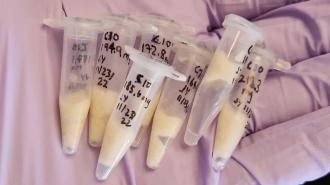A new technique for making lab-grown fat could help ensure cultured meat has both the flavor and texture of the meat that comes from animals.
Why it matters: Traditional meat production is harmful to the environment and, arguably, unethical, but many people like the taste of meat too much to give it up — in fact, global demand for meat has never been higher.
Cultured meat — grown from real animal cells — is molecularly identical to the kind that comes from live animals, so it can taste more like “real” meat than plant-based alternatives. This could make it more appealing to carnivores — if we can get the price down.
Producing large amounts of lab-grown fat similar to the real stuff has proven particularly challenging.
Lab-grown fat: Growing meat similar to ground beef or chicken in significant quantities has proven far easier than creating cuts of meat, which feature a distinctive texture of muscle, fat, and connective tissue.
It’s comparatively easy to grow muscle cells, but producing large amounts of lab-grown fat similar to the real stuff is particularly challenging.
In nature, the circulatory system delivers oxygen and nutrients to our fat tissue, but there are no blood vessels in lab-grown meat — as a result, the cells near the center of a mass of cultivated fat die before the tissue can grow larger than a few millimeters.
Some assembly required: To crack this problem, researchers at Tufts University grew fat cells from pigs and mice in flat layers. They then experimented with different ways to stick the slices of fat cells together into three-dimensional tissues.
“Our goal was to develop a relatively simple method of producing bulk fat,” said researcher John Yuen. “Since fat tissue is predominantly cells with few other structural components, we thought that aggregating the cells after growth would be sufficient to reproduce the taste, nutrition, and texture profile of natural animal fat.”
“Our goal was to develop a relatively simple method of producing bulk fat.”
John Yuen
The results: Based on the Tufts team’s experiments, lab-grown fat bound with alginate — an edible polymer derived from seaweed — has a texture most similar to fat from livestock and poultry.
Lab-grown fat bound with a common food additive (called microbial transglutaminase), meanwhile, was softer, with a texture similar to lard — the researchers say this opens the door to cultured meat producers using a mix of binders in the future to precisely hone the texture of their fats.
While the molecular composition of the lab-grown pig fat wasn’t an exact match for the real stuff, the researchers suspect that lipids could be added to the manufacturing process to close the gap — that should help ensure the cultivated tissue matches the flavor of the real kind.
“We continue to look at every aspect of cultured meat production with an eye toward enabling mass production of meat that looks, tastes, and feels like the real thing,” said researcher David Kaplan.
We’d love to hear from you! If you have a comment about this article or if you have a tip for a future Freethink story, please email us at tips@freethink.com.






